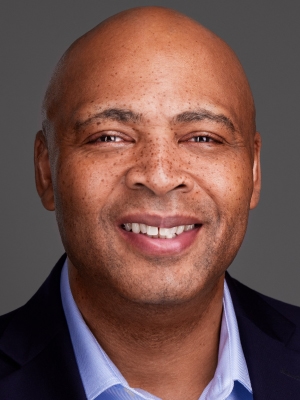Interview with C.H. Robinson CEO: Staying Close to the Work

As a leader in today’s trying business environment, C.H. Robinson CEO Dave Bozeman embraces lean principles, gains insights from his people, and gets close to the work so he can make decisions based on actual data and firsthand experience.

Dave Bozeman, CEO, C.H. Robinson
Soon after Dave Bozeman joined C.H. Robinson as CEO in 2023, he launched a company-wide challenge called What’s Impeding Your Speed? “I asked everyone, ‘What is keeping you from doing your job or going faster in your work?’” he says.
Bozeman expected to send about 345 handwritten notes thanking the global 3PL’s employees for their responses. “But I received 3,400 ideas from more than 2,400 employees,” he says. “That told me we have a speak-up culture, full of people who want to win. It was all very rich data.”
Gaining insights from rank-and-file employees is a signature strategy for Bozeman, who has also held executive positions at Harley-Davidson, Caterpillar, Amazon, and Ford Motor. He recently talked with us about his leadership philosophy and recent efforts to foster continuous improvement at CH Robinson, which is one of the world’s largest logistics platform, offering logistics services, a multimodal transportation management system, and insight from supply chain experts.
IL: What was one event early in your career that helped to shape you as a leader?
When I came to Harley-Davidson in 1992 as an entry-level manufacturing engineer, I badly wanted to carry a two-way radio on the job. Only supervisors carried radios, but I wanted it so much, my superintendent finally handed me one. That obliged me not only to do engineering work, but also to spend time on the floor with the people who worked on the flywheel truing line.
I took a pounding from those people, because they saw me as management. But at the end of several weeks, a few of them said, “We like the way you listen to us and respect us.”
This taught me always to get close to the work and respect the people who do it. When the time came to introduce new processes on the floor, people were cooperative. I’ve carried that lesson throughout my career.
IL: What did you learn from serving as vice president of Amazon Transportation Services during the pandemic?
It was a crazy time for ecommerce. We worked long hours and handled surging volumes with reduced capacity, since everyone had to be six feet apart. I learned never to underestimate the power of innovation and people. We had to innovate quickly and remember that it’s okay to fail. I tell my teams now, you fail, get up, learn fast, and keep moving.
When I look back on that time, I wonder how we made it through. But we became stronger, and we made some important discoveries.
IL: You’re a lean practitioner. How have you been implementing lean principles at C.H. Robinson?
You can’t just walk in and say, “Today we’re going to do lean.” You need to make sure everyone speaks the same language. Maybe people don’t know anything about lean, but if I say I want to reduce waste in all the processes within a company—waste of information, waste of movement—people understand that.
That’s the approach I took at the beginning, walking through discussions of continuous improvement and helping people at Robinson adopt that mindset.
Also, I like to use a lean practice called gemba, which means “go see.” Just as in my Harley-Davidson days, I like to get close to the work. As a leader, that lets me base decisions on actual data and things I have witnessed.
IL: What’s an example of an improvement Robinson has made by implementing lean principles?
We have approximately 100,000 customers. Some of the largest have IT systems that connect directly to our IT systems, allowing for seamless transactions, for example, when they need a quote.
But many other customers, even quite large ones, communicate with us via unstructured data, which generally means email. Then a human needs to do the research and get back to that customer with a quote.
But if you examine that process through the lean framework, you ask how we can take waste out of that system using technology such as generative AI and large language models.
With some of that technology, we can deal with 500,000 unstructured data points daily. The system retrieves the right information, and in some cases it talks back to the customer in a conversational way. Our bar, which we’re hitting, is to get that quote back to them in less than one minute.
IL: What characteristics make you an effective leader?
I hope the people who work around me will say that I’m authentic. I like to communicate consistently and effectively.
Driving the development of others is my responsibility, and it gives me satisfaction. Solving problems through the use of data is very important. So is driving a high bar to take people where they didn’t think they could go.
IL: What’s the hardest aspect of your job?
It’s not lost on me that when I make decisions and take actions, I’m responsible for more than 15,000 employees. We’re in a freight recession right now. People deserve to have leaders who make them feel confident, assuring them that we have a plan to get them through these trying times.
IL: What books do you like to recommend to others?
I gave the whole organization a book called The Lean Turnaround by Art Byrne. As an easy read that gives insights into what lean is, it provided the Rosetta Stone our organization needed, so we could all talk the same language.
On a personal level, one book I love is The Color of Law: A Forgotten History of How Our Government Segregated America by Richard Rothstein.
IL: When you’re not working, how do you spend your time?
Spending time with family is the big thing. My wife and I have been married for almost 31 years. We met in college, and now we have five children ranging in age from 15 to 30—four are out of college, two work in Florida, one is in law school in Oregon, and one works in Arizona.
Also, I’ve become a big-time foodie. I like to cook, and as I have traveled around the world I’ve come to appreciate the power of food to help people connect.
Disruption and Opportunity
Two closely related concerns make C.H. Robinson’s customers especially anxious these days. “Number one is the unknown and number two is variability,” says Dave Bozeman.
Since the pandemic, shippers have been riding a roller coaster, trying to get their supply chains and inventories back to the right levels while dealing with a freight recession. “Customers are thinking, ‘I certainly don’t want to experience the pain I had when I over-ordered during the pandemic,’” says Bozeman. “There were shipping and logistics issues, and a lot of customers were stuck with inventory.
“And it was tough to move goods around the world,” he adds. “So I think they’re being cautious about how and when they order.”
Global turmoil—including attacks on shipping in the Red Sea and disruptions at the U.S.-Mexico border—compound challenges for shippers. For example, as workers at the Big Three automakers ended their recent labor strike, the tight border made it hard for tier one suppliers in Mexico to speed auto parts back into the pipeline. C.H. Robinson helped with creative solutions, such as shifting some shipments to air freight.
“We thrive in disruption,” Bozeman says.
